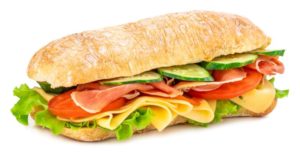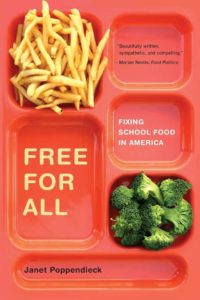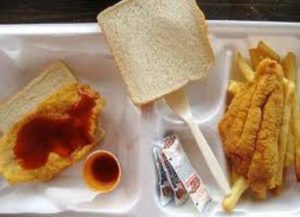by Jane Hersey
Regardless of whether or not you have a child in public school, the food served there has a direct impact on your life.
The cost of educating children with learning or behavior problems.
The biggest budget item in any school system is its special education program. When it does not have the resources to teach a child, his school must pay the tuition for a private facility.
While Virginia spends about $14,000 per year per pupil in the public schools, the cost of special education within those schools runs at least double — and if the child needs a special  school, the cost may run as high as $97,000 a year!! Thirteen percent of Virginia’s school children (about 164,000 children) are enrolled in such a program, and your taxes pay for it. (Source: Virginia Association of Counties)
school, the cost may run as high as $97,000 a year!! Thirteen percent of Virginia’s school children (about 164,000 children) are enrolled in such a program, and your taxes pay for it. (Source: Virginia Association of Counties)
If some of these children no longer needed special ed, and could be returned to their home school’s regular education program, our costs would be dramatically reduced. “Our cost” refers to you and me — the residents of Virginia — who are paying a large chunk of these expenses through property and sales taxes.
If you don’t live in Virginia, you aren’t off the hook — your state has the same problem, although the numbers may be a bit different.
Looking for solutions
 One school system has provided an example — the New York City schools, with over a million students. In the spring of 1979, their public schools ranked in the 39th percentile on standardized California Achievement Test scores. But in a few years their scores rose to the 55th percentile, well above the national average; the only change was in the food they served to the children.
One school system has provided an example — the New York City schools, with over a million students. In the spring of 1979, their public schools ranked in the 39th percentile on standardized California Achievement Test scores. But in a few years their scores rose to the 55th percentile, well above the national average; the only change was in the food they served to the children.
The food service director at that time removed several synthetic additives (artificial dyes, artificial flavors, and three synthetic preservatives), based on the Feingold Diet, and reduced the sugar content.
Fewer kids needed special ed.
Before the change in school food, 12.4% of the students were performing at two or more grades below their proper level. These were the students with a label of “learning disabled” or “low achiever.” When the diet changes were completed in 1983, only 4.9% of the children were still in that category. In other words, 7.6% of a million children — 75,000 students — were now able to perform at a level appropriate for their age.
Changing school behavior
 Another dramatic example of the impact of nutrition took place in a high school in Appleton, Wisconsin. The woman behind this 5-year experiment was Dr. Barbara Reed Stitt, who had worked as a probation officer in Ohio. She coached the prisoners in her care on healthy eating, and as a result, had remarkable success. Typically, only 15% of offenders stay out of jail and 85% of them return. Her success rate was a whopping 85% and only 15% re-offended.
Another dramatic example of the impact of nutrition took place in a high school in Appleton, Wisconsin. The woman behind this 5-year experiment was Dr. Barbara Reed Stitt, who had worked as a probation officer in Ohio. She coached the prisoners in her care on healthy eating, and as a result, had remarkable success. Typically, only 15% of offenders stay out of jail and 85% of them return. Her success rate was a whopping 85% and only 15% re-offended.
Dr. Reed and her husband later funded a project at the Appleton Central Alternative High School, a facility that was so rife with violence, a police officer was on the staff. The students who attended had been expelled from their local schools and many had been in juvenile detention.
 Like the New York schools, the changes in Wisconsin were dramatic. Not only did the teens appreciate the healthy foods they received, but they also changed what they were eating outside of school. The violence, weapons, rudeness were gone, and a police officer was no longer needed. Principal LuAnn Coenen explained that each year she was required to fill out a report on the number of students found using drugs, carrying weapons, or committing suicide. Since the change in food, she noted, “the number in every category has been zero.”
Like the New York schools, the changes in Wisconsin were dramatic. Not only did the teens appreciate the healthy foods they received, but they also changed what they were eating outside of school. The violence, weapons, rudeness were gone, and a police officer was no longer needed. Principal LuAnn Coenen explained that each year she was required to fill out a report on the number of students found using drugs, carrying weapons, or committing suicide. Since the change in food, she noted, “the number in every category has been zero.”
Our nation spends about $85 billion a year to house the prison population. How much would our country benefit if potential felons became law-abiding taxpayers?
Bad school food costs too much
The high cost is not just in human lives, but the “food” so many schools serve is greatly overpriced. It’s a common myth that these “edible substances” are less expensive than real food, but a mom in Vermont demonstrated that made-from-scratch real lunches are less expensive to produce. She became the food service director of a tiny community with only two schools. Before Kathy arrived, the schools were losing $25,000 a year in their cafeterias, but by the third year of cooking real food, she showed a surplus of $12,000.
Excuses, excuses, excuses
At one time school lunches were made by moms in the community who prepared the same dishes they made for their families. But today, many schools have done away with real kitchens in favor of frozen food and a steam table. But even if a school lacks a stove or an oven, there’s plenty that can be done. Some communities have a central kitchen that prepares food  and distributes it to nearby schools.
and distributes it to nearby schools.
Even if there aren’t any other resources, students can still enjoy healthy food — how about sandwiches?
A radical proposal that makes sense
 Happily, some schools are providing real food for their students. And some have even given free meals to all the children, not just those whose families cannot afford the cost, but this program is ending in many parts of the country. That’s sad to hear since the red tape and expenses involved in running free or reduced-fee lunches for some of the children “eats up” dollars that could be spent on real food at no charge. In her book, Free for All, author Janet Poppendieck makes a compelling case for providing good food, just as schools provide libraries, sports and bus transportation, without any added charge.
Happily, some schools are providing real food for their students. And some have even given free meals to all the children, not just those whose families cannot afford the cost, but this program is ending in many parts of the country. That’s sad to hear since the red tape and expenses involved in running free or reduced-fee lunches for some of the children “eats up” dollars that could be spent on real food at no charge. In her book, Free for All, author Janet Poppendieck makes a compelling case for providing good food, just as schools provide libraries, sports and bus transportation, without any added charge.
An even more radical approach
For many years the wealthy community of Fairfax County, Virginia had some of the worst lunches in the nation. Children would toss hot dogs on the floor to see how high they could bounce. They used stacks of paper napkins to soak up the grease coming from pizza with oil-based fake cheese. (The federal government has long provided free cheese — real cheese — to public schools.) Despite countless hours of work on the part of parent volunteers, this didn’t change until the food service director finally retired and a talented chef took her place.
But perhaps there’s a way to have it all — to save millions of taxpayer dollars, while feeding children nourishing, good-tasting food. If the superintendent and school board members were required to eat some of their lunches in their school’s cafeteria, things would change in a hurry!





















